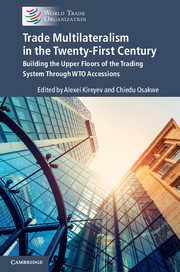 Trade Multilateralism in the Twenty-First Century
Trade Multilateralism in the Twenty-First Century from PART I - WTO Accessions and the New Trade Multilateralism
Published online by Cambridge University Press: 28 November 2017
Abstract
Over the past twenty years, the rules-based global economy has been subject to a dynamic process of transformation. The trading environment has been characterized by shifts in the balance of economic power, emerging structures and rapid changes in global and regional alliances. Since its establishment in 1995, the WTO has sought to adapt to these global trends. The 2017 Trade Facilitation Agreement (TFA), the 2015 Nairobi Decisions on Agriculture, the 2015 expansion of the Information Technology Agreement (ITA) and twenty years of cumulative WTO accessions acquis are all part of this process of constant adaptation by the WTO to a rapidly changing environment.
However, after the Seattle Ministerial meeting in 1999, free trade agreements (FTAs) and regional trade agreements (RTAs) mushroomed. The ‘spaghetti-bowl’ consequences and the continuing proliferation of preferential trade agreements (PTAs) and counter-PTAs have created challenges and opportunities for the rules-based multilateral trading system. Several questions have been raised, revolving around the compatibility and the discriminatory and trade diversion effects of such agreements. Are these agreements building blocks or stumbling blocks for the multilateral trading system? Moreover, the emergence of mega-regional RTAs (MRTAs), in particular the Trans-Pacific Partnership (TPP), have called into question, in some quarters, the power and relevance of the WTO at large.
This chapter examines the core question of whether mega-regionalism (and FTAs by implication) poses an existential risk to the multilateral trading system and argues that the answer is ‘no’. The negotiating results from FTAs, including in their mega-regional forms, and trade multilateralism can coexist in a constructive, healthy and competitive relationship and both are essential for the governance of the multipolar twenty-first-century global economy.
To substantiate this conclusion, the chapter reviews the WTO accessions acquis and compares it to the provisions of the TPP, without pre-judging its future. The comparative analysis is conducted across several areas: market access; trade rules (bilateral/plurilateral/multilateral); trade negotiations as an instrument for domestic reforms; and discriminatory effects. The results of the analysis point to areas of significant complementarity and mutual supportiveness between WTO accession acquis and the TPP, and different degrees of trade liberalization in certain sectors. The accessions acquis demonstrates a process of mutually supportive coexistence between bilateral and plurilateral negotiations and the multilateral legal and policy framework of the WTO.
To save this book to your Kindle, first ensure [email protected] is added to your Approved Personal Document E-mail List under your Personal Document Settings on the Manage Your Content and Devices page of your Amazon account. Then enter the ‘name’ part of your Kindle email address below. Find out more about saving to your Kindle.
Note you can select to save to either the @free.kindle.com or @kindle.com variations. ‘@free.kindle.com’ emails are free but can only be saved to your device when it is connected to wi-fi. ‘@kindle.com’ emails can be delivered even when you are not connected to wi-fi, but note that service fees apply.
Find out more about the Kindle Personal Document Service.
To save content items to your account, please confirm that you agree to abide by our usage policies. If this is the first time you use this feature, you will be asked to authorise Cambridge Core to connect with your account. Find out more about saving content to Dropbox.
To save content items to your account, please confirm that you agree to abide by our usage policies. If this is the first time you use this feature, you will be asked to authorise Cambridge Core to connect with your account. Find out more about saving content to Google Drive.